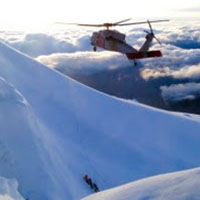— from Mike Welding, Public Affairs Officer —
 A Search and Rescue (SAR) team of five from Naval Air Station (NAS) Whidbey Island conducted a rescue mission on Mount Baker in northern Washington on Friday, July 22, 2016.
A Search and Rescue (SAR) team of five from Naval Air Station (NAS) Whidbey Island conducted a rescue mission on Mount Baker in northern Washington on Friday, July 22, 2016.
The morning SAR alert crew first launched at 9:50 a.m. in an attempt to locate and recover two stranded climbers on the north side of Mount Baker. However, due to severe weather surrounding the mountain, the team of five was unable to reach the scene so they were forced to return to Whidbey Island to await better conditions. Based on forecast environmental conditions, a ground rescue team of four from the Bellingham Mountain Rescue Council (BMRC) was deployed to make their way to the survivors. At 5:20 p.m., the evening SAR alert crew received word from the ground team that the weather had cleared on the mountain, so the helicopter crew readied for launch. The team of five took off at 5:52 p.m. and arrived on scene around 15 minutes later. After a quick search, the crew located both climbers at 10,300 feet, perched on a steep, icy cliff face, surrounded by crevasses. At that point, the survivors had been stranded for more than 40 hours, surrounded by 45 degree slopes of ice where they weathered white-out conditions and snow flurries, and were starting to experience hypothermia and dehydration.
Based on the weight of the aircraft and high elevation, the crew was unable to immediately hover, so they landed on the summit in order to save fuel, unload extra gear, and discuss rescue options with the ground team. After a plan was established, the rescue team began their near-vertical climb 500 feet down to the survivors on the north face. During this time, the SAR helicopter crew completed additional power calculations and took off to assist the ground team with reconnaissance. Upon reaching the climbers’ location, the ground crew determined they would not be able to move the survivors, so helicopter extraction would be the only option.
The helicopter crew conducted power checks and several passes before they came into a hover above the survivors. Once the helicopter was as steady as possible, the SAR Medical Technician (SMT) was carefully lowered to pick up the first person via rescue vest. Once the survivor was safely attached to the SMT, the crew departed to raise them into the helicopter before landing at the summit for offload. With one climber safely atop Mount Baker, the crew took off to recover the second climber. The crew made another approach to a hover next to the cliff face and, this time, the Helicopter Inland Rescue Aircrewman was lowered via the rescue hoist to recover the survivor using the quick strop. With the second survivor onboard, the crew returned to the summit for landing so that they could evaluate the climbers, load all the gear and wait for the ground rescue team to reach the summit once more. The helicopter took off from Mount Baker for the final time at 9:20 p.m. for transit to Bellingham International Airport where they landed to deliver the two cold, but uninjured survivors and four BMRC personnel.
“Although the power margin was small and the terrain was incredibly challenging, we were able to safely rescue the stranded survivors,” said SAR Mission Commander, Lt. Cmdr. Mica Foster. She also added, “The ground party from Bellingham Mountain Rescue was truly impressive and their efforts allowed us to move much faster in the hover.”
This was the 15th rescue of 2016 for NAS Whidbey Island SAR, which has also conducted four searches and eight Medical Evacuation (MEDEVAC) missions this year. The Navy SAR unit operates three MH-60S helicopters from NAS Whidbey Island as search and rescue platforms for the EA-18G aircraft as well as other squadrons and personnel assigned to the installation. The base also has an agreement to assist Washington State and the surrounding areas with medical evacuations and search and rescue activities if other assets are unavailable.
**If you are reading theOrcasonian for free, thank your fellow islanders. If you would like to support theOrcasonian CLICK HERE to set your modestly-priced, voluntary subscription. Otherwise, no worries; we’re happy to share with you.**









Thank you for conducting this truly heroic rescue.
Wonderful rescue, and thanks to those who put their lives at risk to save the duo. I have to wonder, though, why is this an Orcas Issues story?
Hi Donna, I’m glad you asked this question. While our focus is on the local community — Orcas Island and San Juan County — we also report on many regional and state-wide events that impact our lifestyle, such as Native American government, environmental and natural resources, state government that affects our taxing districts such as the schools, the fire and rescue districts, hospitals and ports.
We also cover national organizations that impact us directly, such as military installations like the Whidbey Naval Air Station, whose mission is to defend the Pacific NW. In recent years the Naval Air Station’s Growler operations have caused great consternation among south San Juan County residents, particularly Lopez Islanders.
We think it is also of note that Whidbey Naval Air station is frequently involved in rescue operations in the county and the region. We don’t always agree with our neighbors, but it’s nice to know that sometimes they are true lifesavers.
As a helicopter pilot, I congratulate the crew on an amazing job in treacherously difficult conditions with extremely narrow safety margins. Thank you for putting your lives at risk to save others. While you may simply say this is your job and what you have been trained to do, it really is heroic.
Incredible rescue. Thanks (again) NAS Whidbey SAR!
Thanks for the clarification, Margie.